The Western Digital WD Black SN750 SSD Review: Why Fix What Isn't Broken?
by Billy Tallis on January 18, 2019 8:01 AM ESTRandom Read Performance
Our first test of random read performance uses very short bursts of operations issued one at a time with no queuing. The drives are given enough idle time between bursts to yield an overall duty cycle of 20%, so thermal throttling is impossible. Each burst consists of a total of 32MB of 4kB random reads, from a 16GB span of the disk. The total data read is 1GB.

The Toshiba/SanDisk 3D NAND has consistently shown worse burst random read performance than its competition, and the WD Black SN750 does nothing to change that pattern. The SN750 is insignificantly faster than last year's model, but both the Plextor M9Pe and Corsair MP510 get better read latency out of this NAND by pairing it with different controllers.
Our sustained random read performance is similar to the random read test from our 2015 test suite: queue depths from 1 to 32 are tested, and the average performance and power efficiency across QD1, QD2 and QD4 are reported as the primary scores. Each queue depth is tested for one minute or 32GB of data transferred, whichever is shorter. After each queue depth is tested, the drive is given up to one minute to cool off so that the higher queue depths are unlikely to be affected by accumulated heat build-up. The individual read operations are again 4kB, and cover a 64GB span of the drive.
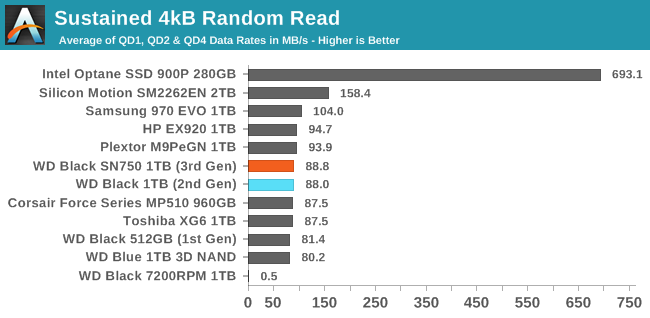
On the longer random read test that also brings in some higher queue depths, the WD Black SN750 is still quite a bit slower than the best combinations of Silicon Motion controller and Micron NAND, but at least this time the drives that use the same Toshiba/SanDisk BiCS3 NAND with different controllers aren't so far ahead of the WD Black.
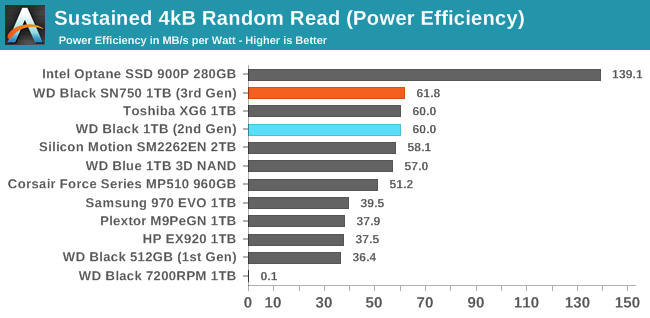 |
|||||||||
| Power Efficiency in MB/s/W | Average Power in W | ||||||||
The WD Black SN750 is just a touch more efficient than its predecessor on the random read test, allowing it to retake a small lead among TLC-based drives here rather than being in a tie with the Toshiba XG6.
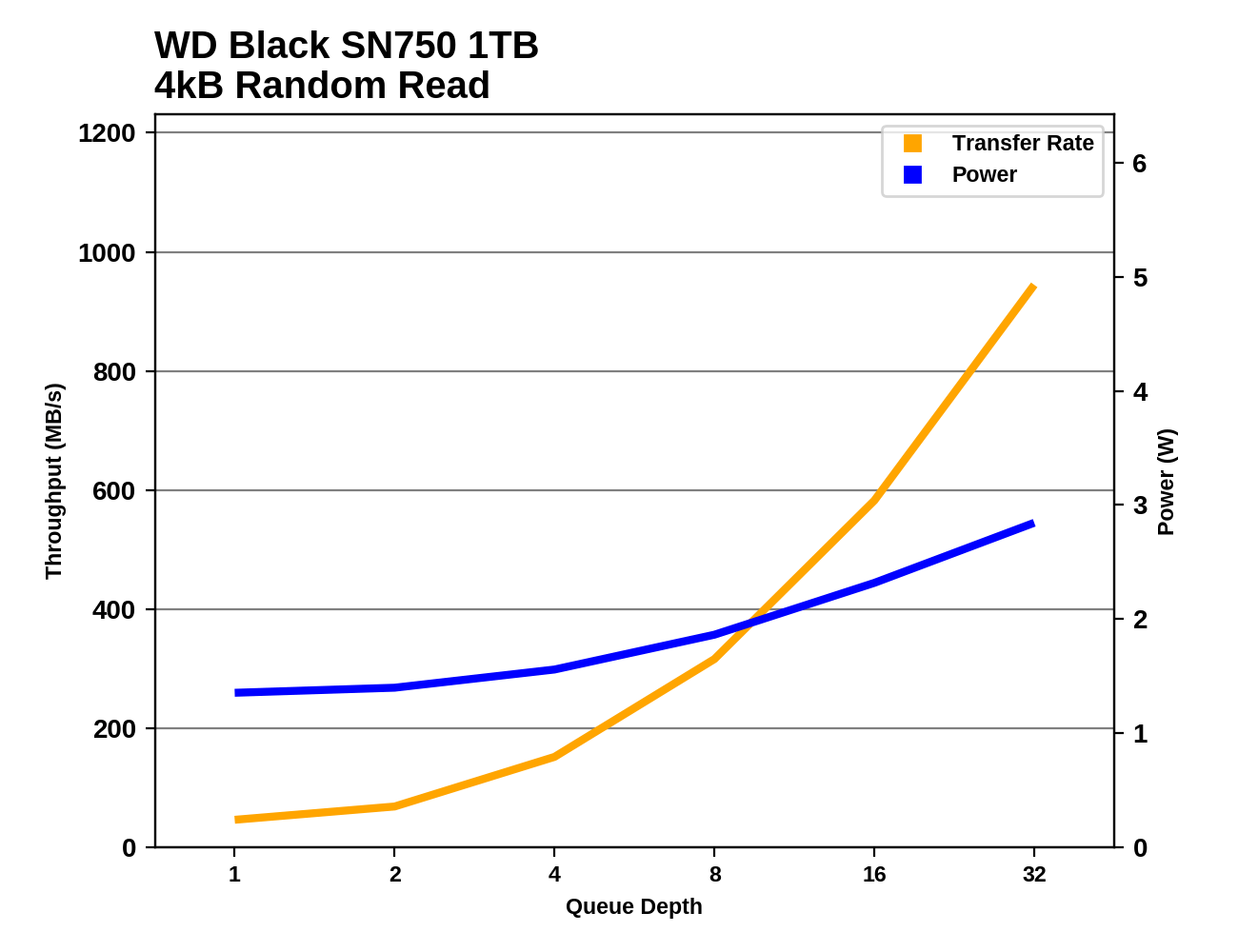 |
|||||||||
When the WD Black SN750 is pitted against most of last year's competition, it does at least catch up if not pull ahead in random read performance at higher queue depths, while never requiring as much power. But the Silicon Motion SM2262EN drives are faster at all queue depths, though not in proportion to how much more power they require.
At low queue depths the random read performance of the WD Black SN750 is down in SATA performance territory where some drives can beat it on performance and power consumption. But at higher queue depths, it is obviously the most efficient NAND-based SSD we've tested for random reads.
Random Write Performance
Our test of random write burst performance is structured similarly to the random read burst test, but each burst is only 4MB and the total test length is 128MB. The 4kB random write operations are distributed over a 16GB span of the drive, and the operations are issued one at a time with no queuing.
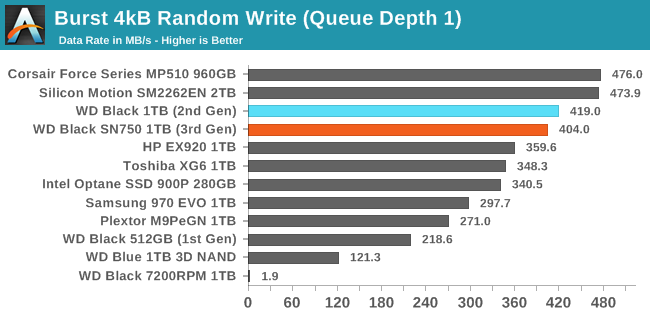
The WD Black SN750 shows a small regression in burst random write performance compared to last year's model. The Corsair MP510 and Silicon Motion SM2262EN engineering sample are nearly tied for first place, with the WD Blacks about 15% slower.
As with the sustained random read test, our sustained 4kB random write test runs for up to one minute or 32GB per queue depth, covering a 64GB span of the drive and giving the drive up to 1 minute of idle time between queue depths to allow for write caches to be flushed and for the drive to cool down.
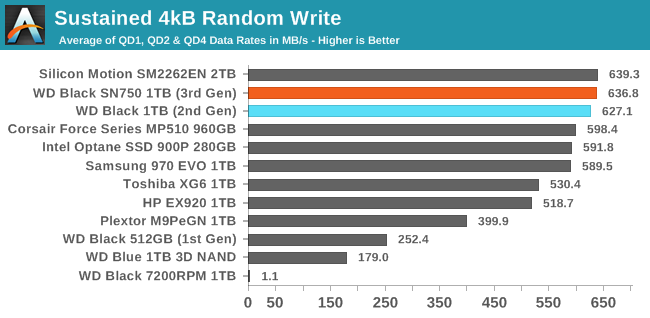
On the longer random write test that brings in higher queue depths, the WD Black SN750 is roughly tied with the SM2262EN sample for first place and is a few percent faster than competitors like the Samsung 970 EVO and Corsair MP510.
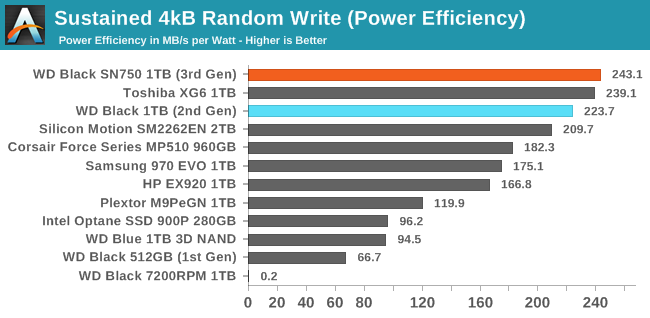 |
|||||||||
| Power Efficiency in MB/s/W | Average Power in W | ||||||||
The SN750 is the most power efficient NVMe drive on our random write test, pulling slightly ahead of the Toshiba XG6 and the older WD Black, and maintaining a substantial lead over most other high-end NVMe drives.
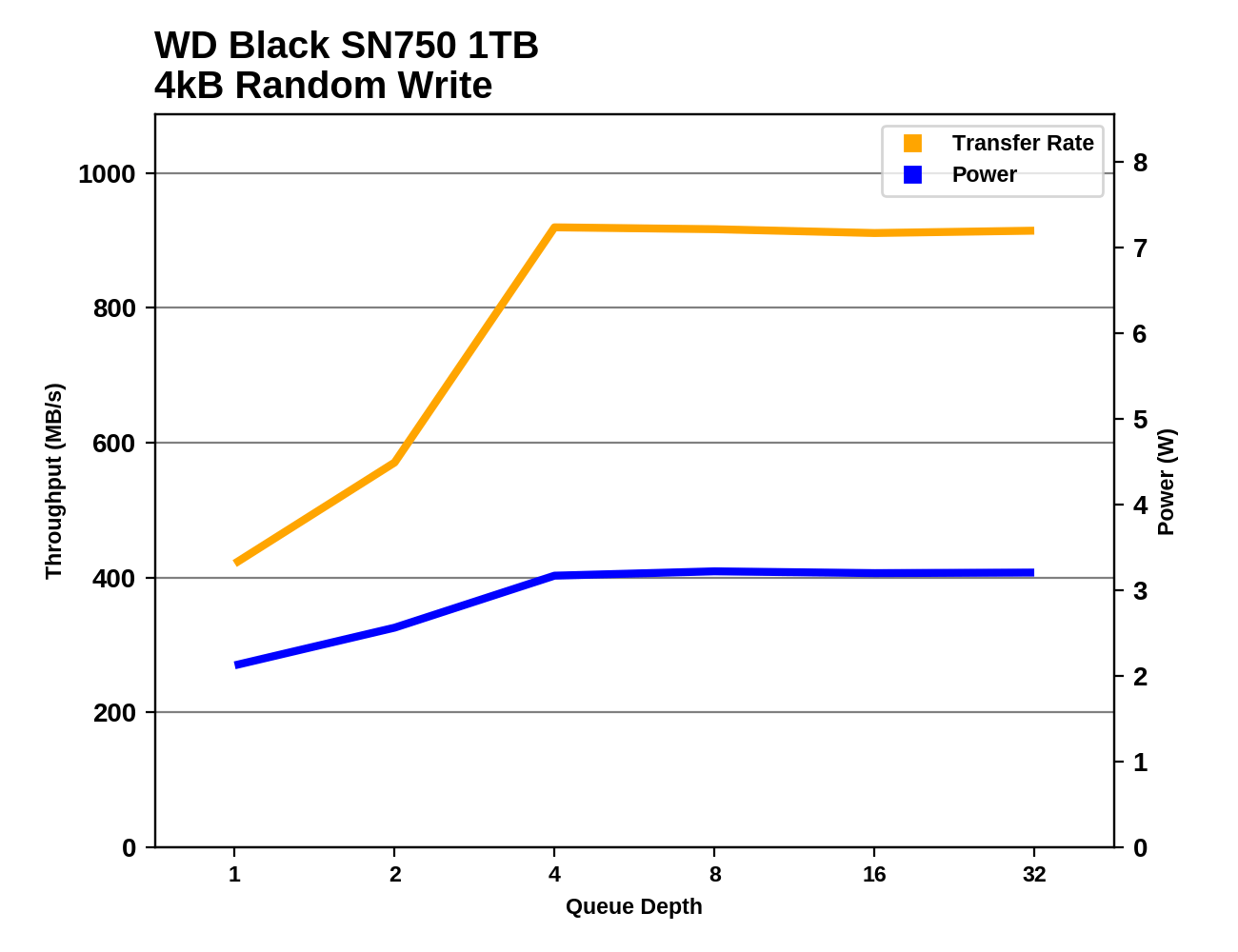 |
|||||||||
The WD Black SN750 hits full speed for random writes with a queue depth of 4 or higher, and maintains steady performance for the rest of the test while drawing just over 3 W.
The WD Black SN750 is very close to the being the most efficient flash-based SSD for random writes that we've ever tested, but there are a few data points in the archive that are slightly faster at similar power levels.


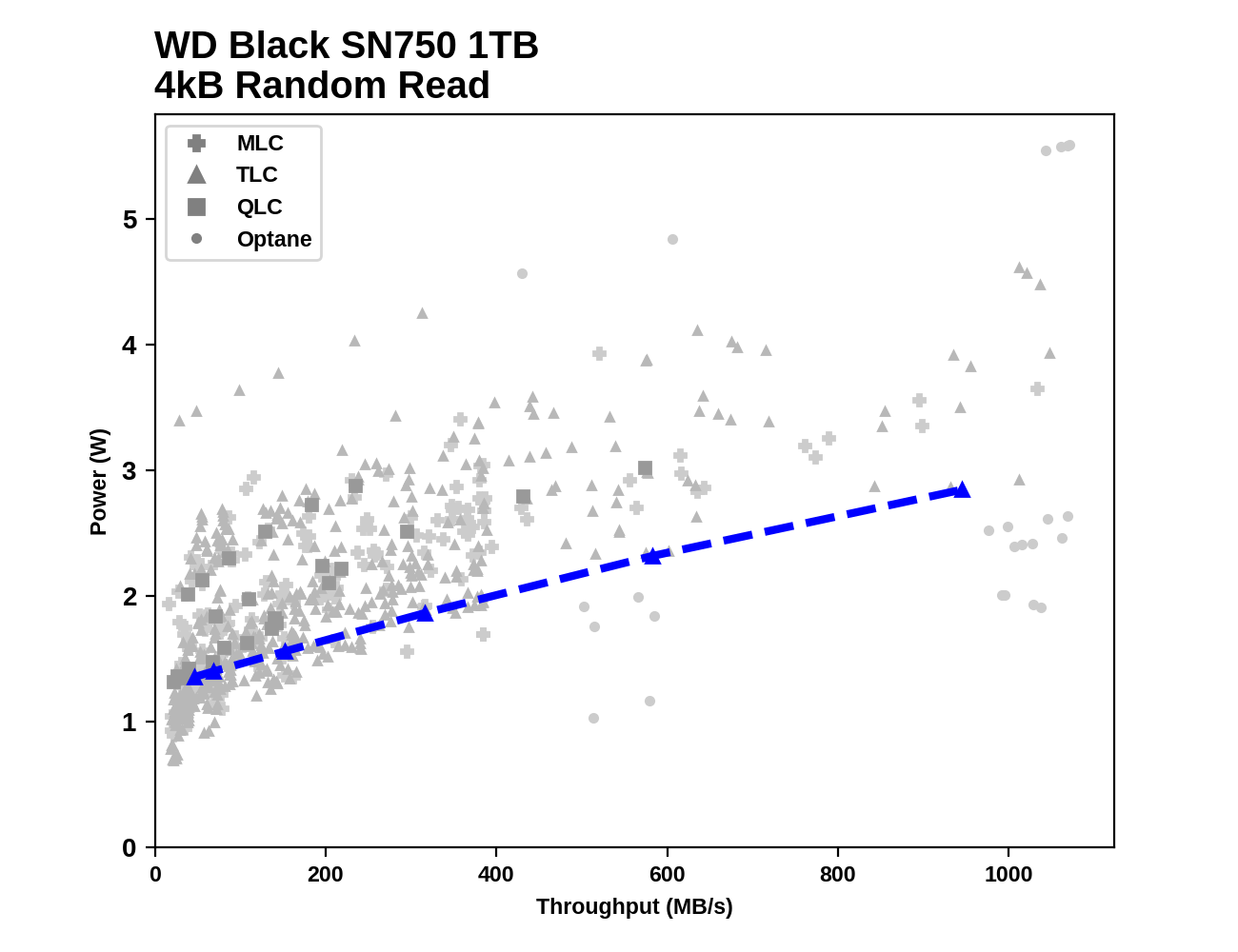
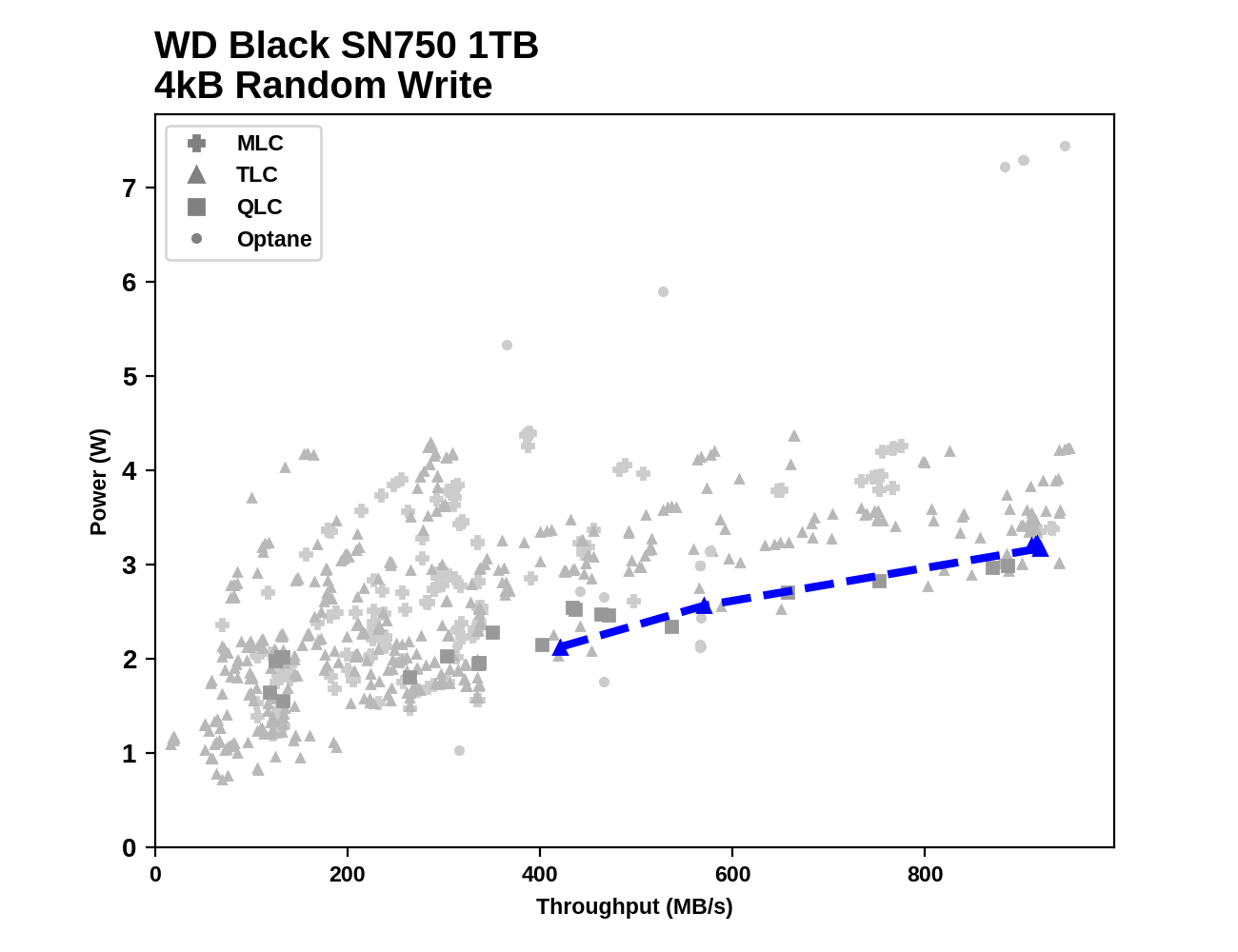








54 Comments
View All Comments
nevcairiel - Friday, January 18, 2019 - link
Whatever happend to the Samsung PRO in those comparisons? If you call something a "top NVMe SSD" and then don't have the PROs in there to stack up against, it feels incomplete.jordanclock - Friday, January 18, 2019 - link
Where do you see that they call it the top NVMe SSD?Comparing it to the 970PRO doesn't make a lot of sense since they are in vastly different price ranges and market segment. The 970 EVO is perfect because they are very close in price and market segment. They even admit in the conclusion that the "970 EVO may be the slightly better performer overall."
Drakkhen - Friday, January 18, 2019 - link
He didn't call it the top NVMe SSD, he said a "top NVMe SSD".But, I agree that it isn't really relevant since this comparison is for a different price point/market.
DanNeely - Friday, January 18, 2019 - link
I would like to see at at least on higher end drive that's not an Optane for comparison though.romrunning - Friday, January 18, 2019 - link
Agreedphilehidiot - Saturday, January 19, 2019 - link
I think it's always useful, regardless of where you are in the meerkat, to compare to the top and the bottom of the range. This gives you an idea of what you're getting. Am I getting 70% of top end performance for 70% of the price or am I getting 95% of it for 70% of the price? Those are two very different value propositions and certainly things we see often in the PC meerkat. Sometimes the progression with price is linear(ish) and sometimes you can spend double the cash to get the very best but really all you're seeing is a few percent extra performance because it takes that much extra R&D / materials investment to get there.29a - Friday, January 18, 2019 - link
In the second paragraph on the last page."the new WD Black is still a very competitive high-end NVMe SSD"
They do make the claim that it is a high end SSE which I would equate to being "a top NVMe SSD" and should be compared to the Samsung Pro models.
althaz - Friday, January 18, 2019 - link
Depends where you are I guess. The 500Gb WD Black is exactly the same price as the 512Gb Samsung 970 Pro where I live. Samsung's 970 EVO drives are $100/TB cheaper.Samus - Monday, January 21, 2019 - link
LOL, the 500GB WD Black is consistently close to half the price of the 980 Pro, and the 970 Pro is essentially the same performance as the EVO (hence them being similarly priced.)I agree, the 980 Pro should be in the benchmarks, but certainly not the 970 Pro. Just use the EVO as a baseline and add 3% if you want to be picky about exact figures.
Samus - Monday, January 21, 2019 - link
I forgot to add, or rather point out, the 970 EVO and 970 PRO share the same controller and are otherwise identical configurations with the exception of the PRO being MLC.That said, Samsung actually rates them near-identically in performance and aside from the SLC caching algorithm, the EVO performs the same.
The only real reason to get the PRO is if you need the DWPD\endurance of MLC. That's literally the only advantage the PRO has.